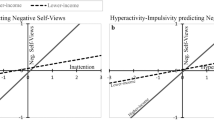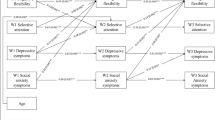Abstract
The present study examined attentional networks performance in 39 adolescents with dysfunctional personality traits, split into two group, Group < 10 and Group ≥ 10, according to the number of criteria they met at the Structured Clinical Interview for DSM-IV Axis II Personality Disorders. The attentional performance has been tested by means of a modified version of the Attentional Network Test (ANTI-V) which allows testing both phasic and tonic components of the alerting system, the exogenous aspect of the orienting system, the executive network and their interactions. Results showed that the orienting costs of having an invalid spatial cue were reduced in the Group ≥ 10 criteria compared to the Group < 10. Moreover, adolescents included in the Group ≥ 10 showed lower conflict when attention was cued to the target location (valid trials) but showed normal interference when there was no overpowering focus of attention (invalid trials). The results found with ANOVA after splitting the sample into two categorical groups were also observed in a complementary correlation analysis keeping intact the continuous nature of such variables. These findings are consistent with the notion that dysfunctional features of personality disorders may represent the psychological manifestations of a neuropsychological abnormality in attention and executive functioning. Finally, we discuss the implications of this attentional anomaly for dysfunctional personality traits and behaviour.



Similar content being viewed by others
Explore related subjects
Discover the latest articles, news and stories from top researchers in related subjects.Notes
The ANT has been developed to obtain an individual index of the three attentional networks (alerting, orienting, and executive control). However, alerting network measures have been usually inferred using only a phasic alertness task. The ANTI-V is useful to achieve also a direct measure of vigilance in addition to the usual ANT scores.
References
American Psychiatric Association (APA) (2000) Diagnostic and statistical manual of mental disorders: DSM-IV-Revisited. American Psychiatric Association, Washington, DC
American Psychiatric Association (APA) (2013) Diagnostic and statistical manual of mental disorders: DSM-V. American Psychiatric Association, Washington, DC
Bleiberg E (2001) Treating personality disorders in children and adolescents. Guilford Press, New York
Breton F, Planté A, Legauffre C, Morel N, Adès J, Gorwood P et al (2011) The executive control of attention differentiates patients with schizophrenia, their first-degree relatives and healthy controls. Neuropsychologia 49(2):203–208
Callejas A, Lupiáñez J, Tudela P (2004) The three attentional networks: on their independence and interactions. Brain Cognit 54(3):225–227
Callejas A, Lupiáñez J, Funes MJ, Tudela P (2005) Modulations among the alerting, orienting and executive control networks. Exp Brain Res 167(1):27–37
Carcione A, Nicolò G, Pedone R, Popolo R, Conti L, Fiore D et al (2011) Metacognitive mastery dysfunctions in personality disorder psychotherapy. Psychiatry Res 190(1):60–71
Casagrande M, Martella D, Ruggiero MC, Maccari L, Paloscia C, Rosa C, Pasini A (2011) Assessing attentional systems in children with attention deficit hyperactivity disorder. Arch Clin Neuropsychol 27:30–44
Coolidge FL, Thede LL, Jang KL (2004) Are personality disorders psychological manifestations of executive function deficits? Bivariate heritability evidence from a twin study. Behav Genet 34(1):75–84
Derogatis LR (1983) SCL-90-R: administration, scoring, and procedures manual, II. Clinical Psychometric Research, Towson
Dimaggio G, Carcione A, Nicolò G, Lysanker PH, D’Angerio S, Conti ML, Fiore D, Pedone R, Procacci M, Popolo R, Semerari A (2013) Differences between axes depend on where you set the bar: associations among symptoms, interpersonal relationship and alexithymia with number of personality disorder criteria. J Personal Disord 27(3):371–382
Dolan M, Park I (2002) The neuropsychology of antisocial personality disorder. Psychol Med 32(03):417–427
Fair DA, Bathula D, Nikolas MA, Nigg JT (2012) Distinct neuropsychological subgroups in typically developing youth inform heterogeneity in children with ADHD. Proc Natl Acad Sci USA 109(17):6769–6774
Fan J, McCandliss BD, Sommer T, Raz A, Posner MI (2002) Testing the efficiency and independence of attentional networks. J Cognit Neurosci 14(3):340–347
Federico F, Marotta A, Adriani T, Maccari L, Casagrande M (2013) Attention network test: the impact of social information on executive control, alerting and orienting. Acta Psychol 143(1):65–70
Federico F, Marotta A, Martella D, Casagrande M (2016) Development in cognitive control of social processing: evidence from the attention network test. Br J Dev Psychol. doi:10.1111/bjdp.12154
Feenstra DJ, Busschbach JJ, Verheul R, Hutsebaut J (2011) Prevalence and comorbidity of Axis I and Axis II disorders among treatment refractory adolescents admitted for specialized psychotherapy. J Personal Disord 25(6):842–850
Fertuck EA, Lenzenweger MF, Clarkin JF (2005) The association between attentional and executive controls in the expression of borderline personality disorder features: a preliminary study. Psychopathology 38:75–81
First MB, Gibbon M, Spitzer RL, Williams JBW, Benjamin LS (1997) Structured clinical interview for DSM-IV Axis II personality disorders, (SCID-II). American Psychiatric Press Inc, Washington, DC
Green DM, Swets JA (1966) Signal detection theory and psychophysics. Wiley, NewYork
Gvirts HZ, Harari H, Braw Y, Shefet D, Shamay-Tsoory SG, Levkovitz Y (2012) Executive functioning among patients with borderline personality disorder and their relatives. J Affect Disord 143:261–264
Hall RC (1995) Global assessment of functioning. A modified scale. Psychosomatics 36(3):267–275
Hiatt KD, Schmitt WA, Newman JP (2004) Stroop tasks reveal abnormal selective attention among psychopathic offenders. Neuropsychology 18:50–59
Jang KL, Livesley WJ, Vernon PA, Jackson DN (1996) Heritability of personality disorder traits: a twin study. Acta Psychiatr Scand 94(6):438–444
Johnson KA, Robertson IH, Barry E, Mulligan A, Dáibhis A, Daly M et al (2008) Impaired conflict resolution and alerting in children with ADHD: evidence from the Attention Network Task (ANT). J Child Psychol Psychiatry 49(12):1339–1347
Kernberg PF, Weiner AS, Bardenstein KK (2000) Personality disorders in children and adolescents. Basic Books, New York
Marotta A, Delle Chiaie R, Spagna A, Bernabei L, Sciarretta M, Roca J et al (2015) Impaired conflict resolution and vigilance in euthymic bipolar disorder. Psychiatry Res 229(1):490–496
Martella D, Casagrande M, Lupianez J (2011) Alerting, orienting and executive control: the effects of sleep deprivation on the attentional networks. Exp Brain Res 210(1):81–89
Martella D, Manzanares S, Campoy G, Roca J, Antúnez C, Fuentes LJ (2014) Phasic and tonic alerting in mild cognitive impairment: a preliminary study. Exp Gerontol 49:35–39
Mazzi F, Morosini P, De Girolamo G, Guaraldi GP (2003) SCID-II, interviste cliniche strutturate per il DSM-IV. Organizzazioni Speciali, Firenze
Morgan AB, Lilienfeld SO (2000) A meta-analytic review of the relation between antisocial behavior and neuropsychological measures of executive function. Clin Psychol Rev 20:113–136
Newman JP, Lorenz AR (2003) Response modulation and emotion processing: implications for psychopathy and other dysregulatory psychopathology. Handbook of affective sciences. Series in affective science. Oxford University Press, New York, pp 904–929
Nicolò G, Semerari A, Lysanker PH, Dimaggio G, Conti L, D’Angerio S, Procacci M, Popolo R, Carcione A (2011) Alexithymia in personality disorders: correlations with symptoms and interpersonal functioning. Psychiatry Res 190:37–42
Ogilvie JM, Stewart AL, Chan RCK, Shum DHK (2011) Neuropsychological measures of executive function and antisocial behavior: a meta-analysis. Criminology 49:1063–1107
Patterson CM, Newman JP (1993) Reflectivity and learning from aversive events: toward a psychological mechanism for the syndromes of disinhibition. Psychol Rev 100(4):716
Petersen SE, Posner MI (2012) The attention system of the human brain: 20 years after. Annu Rev Neurosci 35:73
Posner MI, Rothbart MK (2007) Research on attention networks as a model for the integration of psychological science. Annu Rev Psychol 58:1–23
Posner MI, Rothbart MK, Vizueta N, Levy KN, Evans DE, Thomas KM, Clarkin JF (2002) Attentional mechanisms of borderline personality disorder. Proc Natl Acad Sci USA 99(25):16366–16370
Racer KH, Gilbert TT, Luu P, Felver-Gant J, Abdullaev Y, Dishion TJ (2011) Attention network performance and psychopathic symptoms in early adolescence: an ERP study. J Abnorm Child Psychol 39(7):1001–1012
Raine A, Sheard C, Reynolds GP, Lencz T (1992) Pre-frontal structural and functional deficits associated with individual differences in schizotypal personality. Schizophr Res 7(3):237–247
Raine A, Benishay D, Lencz T, Scarpa A (1997) Abnormal orienting in schizotypal personality disorder. Schizophr Bull 23(1):75–82
Roca J, Castro C, López-Ramóna MF, Lupiáñez J (2011) Measuring vigilance while assessing the functioning of the three attentional networks: the ANTI-Vigilance task. J Neurosci Methods 198:312–324
Roca J, Fuentes LJ, Marotta A, López-Ramón MF, Castro C, Lupiáñez J, Martella D (2012) The effects of sleep deprivation on the attentional functions and vigilance. Acta Psychol 140(2):164–176
Schiffer B, Pawliczek C, Muller B, Forsting M, Gizewsk IE, Leygraf N, Hodgins S (2014) Neural mechanisms underlyng cognitive control of men with lifelong antisocial behavior. Psychiatry Res 222:43–51
Schug RA, Raine A, Wilcox RR (2007) Psychophysiological and behavioural characteristics of individuals comorbid for antisocial personality disorder and schizophrenia-spectrum personality disorder. Br J Psychiatry 191:408–414
Shiner RL (2009) The development of personality disorders: perspectives from normal personality development in childhood and adolescence. Dev Psychopathol 21(03):715–734
Skodol AWE, Johnson JG, Cohen P, Sneed JR, Crawford TN (2007) Personality disorder and impaired functioning from adolescence to adulthood. Br J Psychiatry 190(5):415–420
Spagna A, Martella D, Sebastiani M, Maccari L, Marotta A, Casagrande M (2014) Efficiency and interactions of alerting, orienting and executive networks: the impact of imperative stimulus type. Acta Psychol 148:209–215
Spagna A, Martella D, Fuentes LJ, Marotta A, Casagrande M (2016) Hemispheric modulations of the attentional networks. Brain Cognit 108:73–80
Stanislaw H, Todorov N (1999) Calculation of signal detection theory measures. Behav Res Methods Instrum Comput 31(1):137–149
Tromp NB, Koot HM (2010) Dimensions of normal and abnormal personality: elucidating DMS-IV personality disorder symptoms in adolescents. J Personal 78:839–864
Tyrer P, Johnson T (1996) Establishing the severity of personality disorder. Am J Psychiatry 153(12):1593–1597
Verheul R, Bartak A, Widiger T (2007) Prevalence and construct validity of personality disorder not otherwise specified (PDNOS). J Personal Disord 21(4):359–370
Wan L, Crawford HJ, Boutros N (2006) P50 sensory gating: impact of high vs. low schizotypal personality and smoking status. Int J Psychophysiol 60(1):1–9
Wan L, Friedman BH, Boutros NN, Crawford HJ (2008) P50 sensory gating and attentional performance. Int J Psychophysiol 67(2):91–100
Wilberg T, Hummelen B, Pedersen G, Karterud S (2008) A study of patient with personality disorder not otherwise specified. Compr Psychiatry 49(5):460–468
Zeier JD, Maxwell JS, Newman JP (2009) Attention moderates the processing of inhibitory information in primary psychopathy. J Abnorm Psychol 118(3):554
Acknowledgements
The authors would like to thank all the participants who took part in this study. Dr. Marotta acknowledges Ministry of Education and Science for a “Juan de la Cierva” research contract.
Author information
Authors and Affiliations
Corresponding author
Additional information
Handling Editor: Rubi Hammer (#University of Illinois at Urbana-Champaign); Reviewers: Michael Tennekoon (NIDA, Baltimore), Javier Roca (University of Valencia).
Rights and permissions
About this article
Cite this article
Casagrande, M., Marotta, A., Canepone, V. et al. Dysfunctional personality traits in adolescence: effects on alerting, orienting and executive control of attention. Cogn Process 18, 183–193 (2017). https://doi.org/10.1007/s10339-017-0797-6
Received:
Accepted:
Published:
Issue Date:
DOI: https://doi.org/10.1007/s10339-017-0797-6




